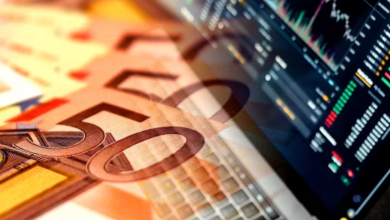Stock Watch – Visa’s Figures Have Performed Solidly
Everyone knows and uses Visa (V.US) cards. However, few understand how the payment process works and which companies are involved. Most importantly, they don’t consider that Visa may be one of the world’s most competitive companies. But beware, because investors do know Visa’s quality, and its shares are already trading at high multiples. Are Visa shares expensive or are they still an opportunity?
How does the card payment sector work?
This process can be divided into the authorization phase and the payment phase. The authorization phase consists of the following steps:
- The buyer wants to pay with his credit card in the store
- The store has its POS and passes the card to detect the data
- This data is sent to the purchaser
- The acquirer receives the information and sends it through the card network (Visa, for example) to the card issuer, which is usually the bank of the person who paid by card.
- The issuer verifies that the person has funds and approves it, sending the information back through Visa to the acquirer.
- The merchant’s POS receives this information and the payment is authorized.
The payment phase is executed as follows:
- The card issuer provides credit on behalf of the consumer to settle the transaction, which is sent through the card network (Visa)
- The card network sends the transaction to the acquirer (payment liquidator, in the case where the work is divided) for settlement.
- The payment liquidator executes the settlement between the card issuer and the bank where the merchant has the account.
- The commercial bank deposits the money into its net commission account or MDR
Source: Visa Annual Report
As we can see, the card network is fundamental to the payment process, as it transmits information from one party to another and facilitates the entire payment process. And if we add to this the fact that the payments sector is of great importance to the global economy, we can safely say that credit and debit card companies are of significant importance in the modern economy.
To give you an idea, in 2024, total global consumer payments are estimated to reach approximately $44.6 trillion, with approximately 15% being made through online commerce. By 2030, global payment volume is expected to reach approximately $58 trillion, representing annualized growth of 4.8%. An important point to note is that, in addition to economic growth itself, another variable that will continue to drive card payments will be the reduction in the use of cash. In 2014, 44% of the value of transactions worldwide were made with cash, while currently the figure is around 15% and is expected to reach 11% by 2030.
Visa vs Mastercard
The card network is formed by an oligopoly, with Visa holding around 55% of the market share, followed by Mastercard at 34%.
In this regard, there are many comparisons between the two companies, but the reality is that Visa usually comes out on top. First, Visa requires far fewer customer incentives than Mastercard does for merchants to use its card network, which already indicates the company’s competitive position.
If we add to this the fact that Visa processes many more transactions than Mastercard, we can explain the difference in margins between the two companies, with Visa the clear winner. Note that few companies in the world have operating margins above 60%, a figure from which we can already deduce the quality of the company.
For its part, Mastercard’s ROCE (return on capital employed) is significantly higher than Visa’s. However, the reason for the difference is worth emphasizing here. Mastercard amortizes its intangibles much more quickly than Visa, which results in lower operating margins but lower capital employed, boosting its ROCE. In any case, both companies enjoy a solid competitive position, as their figures demonstrate.
How does Visa make money?
Visa is the nexus of the entire system, connecting the acquirer and the issuer. It is a fundamental step in the payment process, as the correct information must be transmitted to approve or reject a payment in a short time, with a low or zero failure rate. Regarding its revenue streams, they can be divided into:
- Services: These are revenues derived from transaction routing processes and are received even if the transaction is routed outside the Visa network (for example, to the Mastercard network).
- Data processing: Received when payment is made through the Visa network, typically via VisaNet. This includes revenue from the authorization, settlement, and payment of the transaction.
- International transactions: are income received from international transactions and currency exchanges
- Other revenues: These are a very residual part of the revenues and are attributed to consulting services, marketing and license payments for the use of the Visa brand or technology.
Typically, data processing depends on a fixed fee for each transaction, while services and international transactions depend on the volume of money.
What are Visa’s competitive advantages?
Visa has three competitive advantages that allow it to achieve returns and margins higher than those of the market, although the first two are the most important:
- Network effect: This occurs when the value of your ecosystem grows as the number of users increases. In this sense, it is Visa’s greatest competitive advantage, as its network is valuable due to the large number of merchants that accept its card. So much so that Visa also charges for services to route transactions made on another network. Furthermore, we believe it will allow Visa to capture a significant portion of payments shifting from cash to other digital means. This will also allow Visa to expand into markets where it operates with limited market share, increasing incentive payments in the short term.
- Economies of scale: Due to the large number of transactions it carries out, fixed costs are considerably diluted, and each additional transaction is highly profitable, leading to these large margins given the operating leverage.
- Switching costs: It’s difficult to use another network instead of Visa or Mastercard because of the risk of payments not being accepted, security breaches, or even slower transaction speeds.
Visa Stock Valuation: What’s The Price Target?
Visa’s figures have performed solidly, with revenue increasing by 10.3% annualized over the 2017-2024 period and 9.4% annualized over the 2019-2024 period, despite the pandemic. Its margins, meanwhile, have allowed its EBIT to grow by 10% and 10.6% in the latter period reported, while diluted earnings per share have soared by 19.5% and 12.8%, respectively. All this while its free cash flow increased by 15.6% annualized and 10.6% annualized, respectively.
This information, combined with growth opportunities in segments such as global payments, where the market size is around $200 billion, leads us to believe that Visa will be able to grow at a faster pace than the market. In specific, we think that revenue will grow at a 13.5% annualized rate, with expansion of margins and a EBIT annualized rate growth of 14.4%.
To value Visa shares, we used discounted cash flows and multiples. Both methods gave us a reduced, albeit positive, potential.
For the final target price, we decided to weight both methods, giving us a target price for Visa shares of $390.2. This represents a potential upside of around 16%, while the annualized return if this price were reached in three years would be just 5.2%.
However, we must emphasize that Visa’s quality makes us positive about the company, and we believe it will continue to generate shareholder value.
The material on this page does not constitute financial advice and does not take into account your level of understanding, investment objectives, financial situation or any other specific needs. All information provided, including opinions, market research, mathematical results and technical analyzes published on the Website or transmitted To you by other means, it is provided for information purposes only and should in no way be construed as an offer or solicitation for a transaction in any financial instrument, nor should the information provided be construed as advice of a legal or financial nature on which any investment decisions you make should be based exclusively To your level of understanding, investment objectives, financial situation, or other specific needs, any decision to act on the information published on the Website or sent to you by other means is entirely at your own risk if you In doubt or unsure about your understanding of a particular product, instrument, service or transaction, you should seek professional or legal advice before trading. Investing in CFDs carries a high level of risk, as they are leveraged products and have small movements Often the market can result in much larger movements in the value of your investment, and this can work against you or in your favor. Please ensure you fully understand the risks involved, taking into account investments objectives and level of experience, before trading and, if necessary, seek independent advice.






